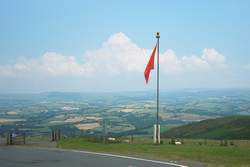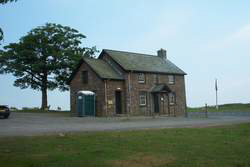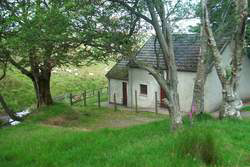Abandoned Communities ..... Mynydd Epynt
At the beginning of World War II the War Office urgently needed extra land and facilities for training purposes. One particular requirement was for an area at least three miles long that could be used for artillery practice. Mynydd Epynt and a smaller mountain to the west of it, Mynydd Bwlch-y-groes, were selected. The process of acquisition was completed by 30 June 1940, and the area became know as the Sennybridge Training Area, usually abbreviated to SENTA. Sennybridge itself is a small town on the A40 a few miles west of Brecon, and the training area comprises about 12,000 hectares to the north of it.
Until 1940 the area was occupied by a community of farmers and their families. In order to create SENTA 54 homes had to be vacated and 219 people were obliged to leave. At the same time a primary school, a church, and the Drovers Arms inn were closed.
There is evidence that the military authorities had carried out an initial reconnaissance of Mynydd Epynt in 1912. When World War II began it was clear that the area satisfied the criteria used by the War Office for selecting land for training. Although it was home to a community of farmers it was perceived as being sparsely populated, and it did not have a major road running through it. It would be interesting to know whether other places were considered at the same time and some kind of option appraisal carried out, but I have so far been unable to discover whether this was done. It seems more likely that as the authorities were already aware of Mynydd Epynt and regarded it as suitable for their requirements they quickly went ahead with its acquisition.
A detailed and often moving account of the way of life of people living on Mynydd Epynt has been given by Herbert Hughes.
Herbert Hughes, An Uprooted Community: A History of Epynt, Gomer Press, 1998.
Hughes' book was intended to act as a lasting memorial to those who were displaced, and the names of all 219 of them are listed in an appendix. Much of the book is based on interviews with some of the former residents, and it is illustrated with photographs of pupils and staff at Cilieni Primary School, several farmsteads, Babell Chapel and its accounts book, and the Llangamarch Horse Fair. Photographs of residents show people standing outside their homes, having a drink together, rounding up sheep, and, in the case of Mrs Caroline Evans, the landlady of the Drovers Arms, operating a plunging churn.
Some of the interviews transcribed by Herbert Hughes talk about methods of agriculture, and the diversity of ways in which the products of agriculture were used. Wheat and oats were grown. Sheep were reared, and pigs and cattle were kept. The area had for centuries been renowned for its horses. Indeed the name Epynt comes from a Brythonic word meaning the place of the horse.
Brythonic was the Celtic language from which Welsh emerged.
Farmers and their families have a reputation for leading somewhat isolated lives, but there is no doubt that the people of Mynydd Epynt formed a close and cohesive social community. There were everyday informal contacts and the sharing of farm work, and in addition regular markets, the primary school, and the chapel each provided a focus for interaction. On a television programme in 1972 Annie Williams, who lived near Babell chapel, described the Plygain, the service that took place early on Christmas morning. She would light the oil lamps and the stove in the chapel at 5 o'clock and then from the window of her home would watch people arriving for the service. Each family would be carrying a stable lamp to help them see the way. Mrs Williams was able to name the farms that each family came from.
A special form of social gathering was the eisteddfod, a series of musical competitions with particular emphasis on choral singing. Eisteddfodau were held in several villages in the area as well as at Babell chapel. To get to them people would walk long distances over the mountains, and it is said that such was the eagerness to take part that they would sometimes continue until two o'clock in the morning.
Until 1940 the area was occupied by a community of farmers and their families. In order to create SENTA 54 homes had to be vacated and 219 people were obliged to leave. At the same time a primary school, a church, and the Drovers Arms inn were closed.
There is evidence that the military authorities had carried out an initial reconnaissance of Mynydd Epynt in 1912. When World War II began it was clear that the area satisfied the criteria used by the War Office for selecting land for training. Although it was home to a community of farmers it was perceived as being sparsely populated, and it did not have a major road running through it. It would be interesting to know whether other places were considered at the same time and some kind of option appraisal carried out, but I have so far been unable to discover whether this was done. It seems more likely that as the authorities were already aware of Mynydd Epynt and regarded it as suitable for their requirements they quickly went ahead with its acquisition.
A detailed and often moving account of the way of life of people living on Mynydd Epynt has been given by Herbert Hughes.
Hughes' book was intended to act as a lasting memorial to those who were displaced, and the names of all 219 of them are listed in an appendix. Much of the book is based on interviews with some of the former residents, and it is illustrated with photographs of pupils and staff at Cilieni Primary School, several farmsteads, Babell Chapel and its accounts book, and the Llangamarch Horse Fair. Photographs of residents show people standing outside their homes, having a drink together, rounding up sheep, and, in the case of Mrs Caroline Evans, the landlady of the Drovers Arms, operating a plunging churn.
Some of the interviews transcribed by Herbert Hughes talk about methods of agriculture, and the diversity of ways in which the products of agriculture were used. Wheat and oats were grown. Sheep were reared, and pigs and cattle were kept. The area had for centuries been renowned for its horses. Indeed the name Epynt comes from a Brythonic word meaning the place of the horse.
Brythonic was the Celtic language from which Welsh emerged.
Farmers and their families have a reputation for leading somewhat isolated lives, but there is no doubt that the people of Mynydd Epynt formed a close and cohesive social community. There were everyday informal contacts and the sharing of farm work, and in addition regular markets, the primary school, and the chapel each provided a focus for interaction. On a television programme in 1972 Annie Williams, who lived near Babell chapel, described the Plygain, the service that took place early on Christmas morning. She would light the oil lamps and the stove in the chapel at 5 o'clock and then from the window of her home would watch people arriving for the service. Each family would be carrying a stable lamp to help them see the way. Mrs Williams was able to name the farms that each family came from.
A special form of social gathering was the eisteddfod, a series of musical competitions with particular emphasis on choral singing. Eisteddfodau were held in several villages in the area as well as at Babell chapel. To get to them people would walk long distances over the mountains, and it is said that such was the eagerness to take part that they would sometimes continue until two o'clock in the morning.
One
The northern boundary of the military training area
The Drovers’ Arms Inn
Ffrwd-wen farmhouse, once the home of the Jones family


